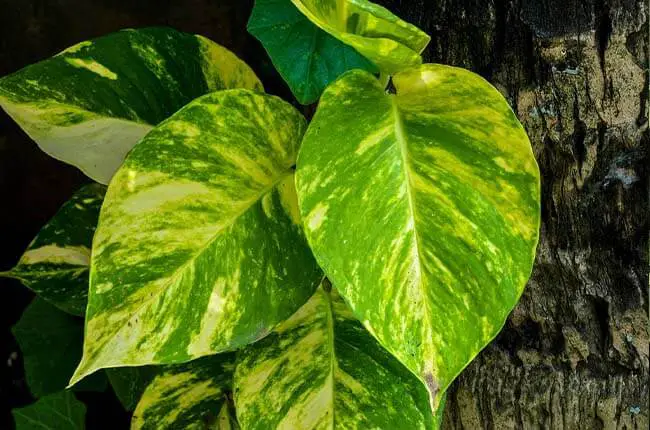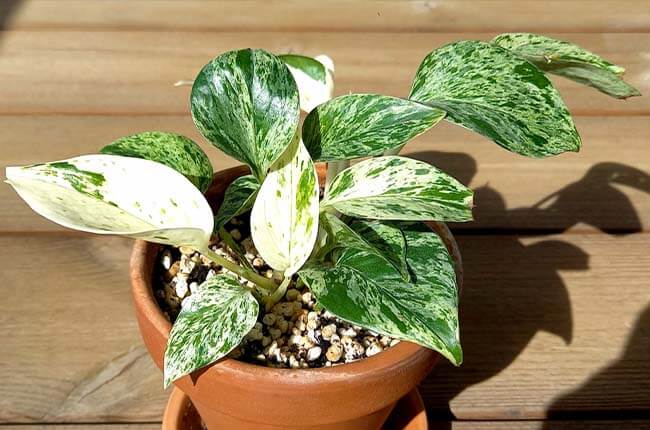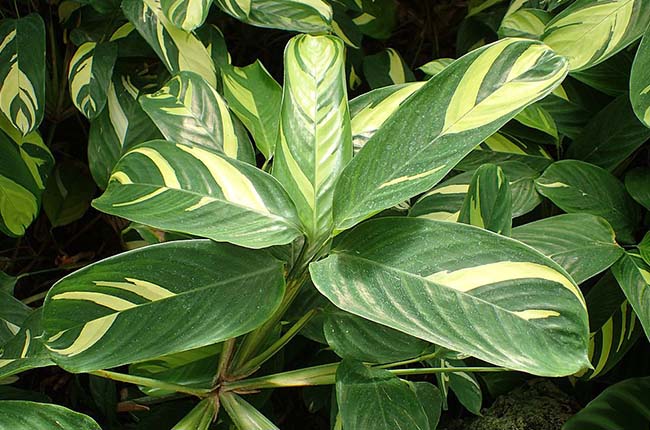Plants with irregular variegated patterns on different leaves are unique and beautiful. But such variegation is unstable, and it will revert back to its all-green state.
Plants with unstable variegation are cultivars that do not have the same variegated patterns on all the leaves. To prevent the variegation from reverting back to green, adequate lighting should be provided for these plants and green leaves should be pruned.
In a previous article, we explained how to find plants with stable variegation.
In this article, we have found 14 plants with unique but unstable variegated patterns. We will also cover some tips on how to prevent them from losing their variegation.
Which type of variegation in plants is unstable?
Plants that do not have the same variegated pattern on the entire plant (in other words, irregular patterns on different leaves) have unstable variegation.
The instability of the variegation can be caused by chemicals, viruses, or cell mutation on only portions of the meristem.
Plants with unstable variegation are cultivars or chimeras with genotypes from two plant species, created by tissue culture in the laboratory. Their variegation is thus called chimeral variegation.
Whether a cultivar has stable chimeral variegation depends on the cell mutation that takes place at the apical meristem, or at the shoot tips where new cells are produced. Mutated cells that cannot synthesize the green pigment, chlorophyll, manifest as white or colors other than green.
Unstable forms of chimeral variegation are “sectorial” and “mericlinal”, where only portions of the cells at the shoot tips are mutated or lacking the green pigment, chlorophyll, and the other cells are normal.
Sectorial and mericlinal variegations are unstable and typically appear differently on individual leaves. It could be a line, a patch on half of a leaf, three-quarters of a leaf, or even the entire leaf. And some leaves could be heavily variegated, slightly variegated, or not variegated at all.
These cultivars are not true-to-seed, meaning the variegation of the cultivars cannot be reproduced via seeds. Attempts can be made to propagate the stem cuttings with variegation but it is not a guarantee that it will grow into a plant with variegation.
Plants with unstable variegation
Plants with unstable variegation have variegation patterns and sizes that vary from leaf to leaf. Here are 10 examples of such plants:
1. Philodendron Pink Princess
The Philodendron Pink Princess (Philodendron erubescens ‘Pink Princess’) is a cultivar of the Blushing Philodendron. Native to Columbia, this stunning rare plant is a climber with large, heart-shaped and waxy leaves that can be up to 9 inches (22 cm) long.
Its unique variegation appears as bubblegum-pink patches or stripes on the dark-green leaves. The size, shape, and location of the pink coloration differ from leaf to leaf that some leaves could be entirely pink, while others could have little or no pink at all.
The variegation is chimeral, caused by some mutated cells that do not contain chlorophyll, thus showing the pink pigment of anthocyanins.
The variegation is unstable because the mutation is sectorial, where not all the cells at the shoot tips are mutated. The plant can thus revert to a dark-burgundy color or even green if the plant is given insufficient light.

(Cliff from Arlington, Virginia, USA, CC BY 2.0, via Wikimedia Commons)
2. Philodendron ‘Birkin’
Philodendron ‘Birkin’ is a variegated variety of the Philodendron Rojo which is a hybrid of two other Philodendron species. It is a compact evergreen plant with broad oval-shaped leaves.
This common houseplant has fine white or yellow lines that radiate from the center of the green leaves to the margins. The chimeric variegation is unstable and the plant can lose its variegation, reverting to a solid green. This usually happens when the plant doesn’t get enough light and reverts to green to catch more light. Temperature stress may also make the plant revert as it tries to recover.

(credits: Dan Jones)
3. Philodendron Brasil
Philodendron Brasil (Philodendron hederaceum ‘Brazil’) is a cultivar of the heart-leaf philodendron native to South America. It is a vining evergreen plant with small heart-shaped leaves.
The plant is variegated with lemon/neon coloring that typically covers the entire midrib of the leaves. The variegation can have different thicknesses, ranging from a thin line to as wide as covering half of the leaf. But in all cases, the midrib always has the variegation.
This chimeral variegation is unstable and can revert to an all-green plant when the plant doesn’t receive adequate light.

( Photo by Kate Rubiani on Unsplash )
4. Monstera Albo
Monstera Albo (Monstera deliciosa ‘Albo Variegata’) is a variegated cultivar of the popular Monstera Deliciosa or Swiss Cheese Plant. The plant is an evergreen perennial with broad leaves that develop fenestrations as the plant grows.
This variegated cultivar shows sections of white on the fenestrated green leaves. The white portions are typically in large patches and streaks. Occasionally some leaves are completely white, with tiny flecks of green. It’s also common to see one half completely white and the other half green. But some leaves can have little or no variegation, and appear mostly green.
The chimeral variegation in Monstera Albo is sectorial that only portions of the leaves are mutated without chlorophyll.
It can thus revert to all green if the plant gets little light or if exposed to extreme temperatures.

(Photo by Huy Phan on Unsplash )
5. Golden Pothos
Golden Pothos (Epipremnum aureum ‘Devil’s Ivy’) is one of the several variegated cultivars of the Pothos plant. This popular houseplant is a vining evergreen with aerial roots and small heart-shaped leaves.
Its variegation manifests as numerous streaks and bands of yellow originating from the midrib of the leaves. Some leaves are heavily variegated, appearing almost entirely yellow, while others have just a few streaks of yellow.
The variegation is chimeral with some mutated cells in the leaves without chlorophyll. The plant can lose its variegation if it does not get sufficient sunlight.

(Photo by Joydeep / Wikimedia Commons)
6. Marble Queen Pothos
Marble Queen Pothos (Epipremnum aureum ‘Marble Queen’) is another cultivar of the pothos plant.
The plant is very similar to the golden pothos, and the only difference is the color of the variegation is cream rather than yellow.
Like the Golden Pothos, the variegation on the Marble Queen will revert if the plant doesn’t receive enough sunlight.

(Spnq, CC BY-SA 4.0, via Wikimedia Commons)
7. Philodendron Burle-Marxii
Variegated Burle Marx (Philodendron Burle-marxii ‘Variegata’) is a cultivar of the Philodendron Burle Marx. It is a vining evergreen plant with large elongated heart-shaped leaves.
The variegation of this plant appears as yellow, lemon, and light green patches scattered over the leaves. The pattern is different on each leaf. Some leaves have just one color of variegation while others can have all three.
Half-moon leaves are common on the plant, where half of the leaf is completely variegated with yellow or cream, while the other half is solidly green.
Burle Marx variegation is chimeral and is unstable. It can revert to all green if it doesn’t receive enough light.
8. Stromanthe Triostar
Stromanthe Triostar (Stromanthe sanguinea ‘Triostar’) is a variegated cultivar of the Stromanthe sanguinea, a herbaceous perennial. It has thick and oblong variegated leaves with a pink/burgundy-colored underside.
The leaves show irregular variegation patterns of cream, pink, and green on the surface. The cream color on the surface appears as pink on the undersides, while the green areas appear as purple/burgundy.
The degree of variegation differs between the leaves, with some leaves being almost entirely cream colored with some streaks of green, while other leaves might be mostly green with small areas of cream.
The variegation is unstable and can revert if the plant doesn’t get sufficient light. On the other hand, too much light can cause the leaves to curl and lose variegation, as plants in the stromanthe genus naturally grow in dim light in forests.

(Hardyplants, CC0, via Wikimedia Commons)
9. Calathea White Fusion
Calathea White Fusion is a cultivar of Goeppertia lietzei (Goeppertia lietzei ‘Fusion White’). It is an evergreen perennial with long, narrow, lanceolate leaves.
The leaves have white and green variegation on the surface and a pink and magenta/burgundy variegation on the underside. The pattern of variegation differs between the leaves, but typically manifests as bands of white and green, but some leaves may have large swatches of white or green that cover a great portion of the leaves. The variegation on the top of the leaves translates to the underside. With white areas appearing pink, and green areas appearing purple/burgundy.
This variegation is chimeral variegation that results from mutated cells in the leaves. The white areas are cells that don’t contain chlorophyll. The mutation and the resulting variegation is unstable, and the plant can revert to green.
Proper lighting is important for this plant. Too little light can make it lose its variegation, and the same can happen with too much light, as naturally, Calatheas grow in the dim light of the forest canopy.
10. Golden Mosaic
Golden mosaic (Ctenanthe Lubbersiana ‘Golden mosaic’) is a variegated cultivar of the Bamburanta plant, an evergreen perennial with oblong leaves that emerge from bamboo-like stems.
The leaves have bands of lemon green radiating outward from the mid vein. The variegation differs from leaf to leaf, with some being almost entirely lemon green, while others have only a single band.
The variegation is a result of the plant being a chimera with mutated cells than can’t produce or synthesize chlorophyll. The mutation is likely sectorial as the variegation often spreads from the center of the plant to the margins.

(Krzysztof Ziarnek, Kenraiz, CC BY-SA 4.0, via Wikimedia Commons)
How to maintain variegation?
– Provide adequate light
Variegated plants have lower chlorophyll levels for photosynthesis, as such, they need more light to produce the same amount of energy that non-variegated plants produce.
Lack of sunlight can make a plant lose its variegation, as it compensates by becoming greener to be better able to absorb the reduced amount of light.
Put your variegated plant on the brightest window or location in your home, and ensure that it continues to get sunlight throughout the day. But it should be indirect light, as direct sunlight can be harmful to plants, especially variegated ones.
– Prune non-variegated leaves
Non-variegated leaves have more chlorophyll, and will thus grow faster and better and can overtake the variegated leaves. By pruning the non-variegated leaves, the plant is forced to focus energy on the variegated ones.
– Use Low-Nitrogen Fertilizers
Nitrogen is an essential plant nutrient. But too much of it increases chlorophyll production and foliar growth, resulting in greater foliar growth with darker coloring. Therefore, if the plant receives more nitrogen, its unstable variegation can easily revert.
– Keep variegated plants in pots
Variegated plants are more sensitive to temperature and light changes than non-variegated plants. Having them in pots makes it easy to relocate them to a better position when temperatures or lighting conditions aren’t favorable, or when you notice the plant losing variegation.
Happy gardening!
Related
How To Find Plants with Stable Variegation: 7 Examples
4 Ways To Induce Variegation In Plants (Explained)
References
Lineberger, R. D. & Texas A&M University. (n.d.). Origin, Development and Propagation of Chimeras. Texas A&M University.
Frank, H., & Chitwood, D. H. (2016). Plant chimeras: The good, the bad, and the ‘Bizzaria’.
University of Florida. (n.d.). Genetic Selection, Chimeras.
- Top 6 Drip Irrigation Systems for Raised Beds (2025) - January 31, 2025
- Top 10 Orchid Fertilizers: A Comprehensive Review (2025) - January 16, 2025
- Top 6 Slow-Release Fertilizers for Houseplants & Veggies (2025) - January 15, 2025

